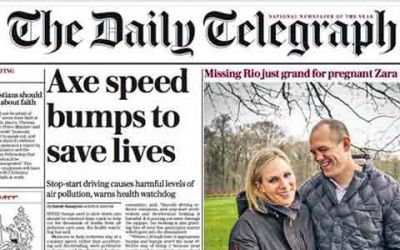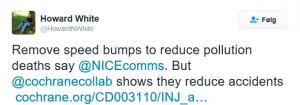

Howard White is the CEO of the Campbell Collaboration. Cross-posted, with permission, from the Campbell Blog.
The National Institute for Clinical Evidence (NICE) has produced new consultation guidance on ‘Air pollution - outdoor air quality and health’. Not very newsworthy you might think. Well you’d be wrong.
 The Telegraph (UK) ran the story on the front page under the headline ‘Axe Speed Bumps to Save Lives: NICE says “speed bumps could be removed to cut pollution”.' Whilst somewhat less dramatic, the same spin on the story was across the media:
The Telegraph (UK) ran the story on the front page under the headline ‘Axe Speed Bumps to Save Lives: NICE says “speed bumps could be removed to cut pollution”.' Whilst somewhat less dramatic, the same spin on the story was across the media:
- ITV News: Could speed bumps be a thing of the past?: “Councils should promote smoother driving and consider removing speed bumps to cut down on harmful pollution, a health watchdog said”.
- The Guardian: ‘UK health body proposes removal of speed bumps to cut air pollution’: ‘Speed bumps should be removed… health experts have said’.
- And of course the car lobby, such as the website Carthrottle.com, picked up the story too: 'It's official: Speed bumps are terrible for the environment and need to die'.
But doesn’t traffic calming such as speed bumps save lives? I checked the Cochrane Library, which confirmed that ‘Area-wide traffic calming may have the potential to reduce death and injuries’ though – as usual – more research is needed. So I tweeted that NICE was recommending removing speed bumps, but the trade-off with the benefits of traffic calming needed to be taken into account. NICE replied that they ‘haven't called for a ban on speed bumps or their removal’. So I turned to the NICE website. Indeed the guideline has just one reference to speed bumps, which states that ‘Evidence on traffic-calming measures such as speed bumps suggested that these may increase emissions by adding to decelerations and accelerations. Evidence from area-wide schemes does not show increases. So where physical measures are needed to reduce road injuries they should be designed to minimise their impact on air pollution. The evidence was weak, so this was a "consider" recommendation.'
 So NICE were right that they hadn’t recommend to ‘axe speed bumps’. But they were uniformly and widely misreported as having done so. Is that the fault of the media for sensationalizing, and thus misrepresenting, the story? Or is it the fault of NICE for not handling the story well? As communicators of evidence, we surely have a responsibility to do the best we can to ensure that the evidence is not misrepresented and misused by those with an axe to grind.
So NICE were right that they hadn’t recommend to ‘axe speed bumps’. But they were uniformly and widely misreported as having done so. Is that the fault of the media for sensationalizing, and thus misrepresenting, the story? Or is it the fault of NICE for not handling the story well? As communicators of evidence, we surely have a responsibility to do the best we can to ensure that the evidence is not misrepresented and misused by those with an axe to grind.
We welcome views on comments on how to better communicate ‘complex evidence’ to the media.

